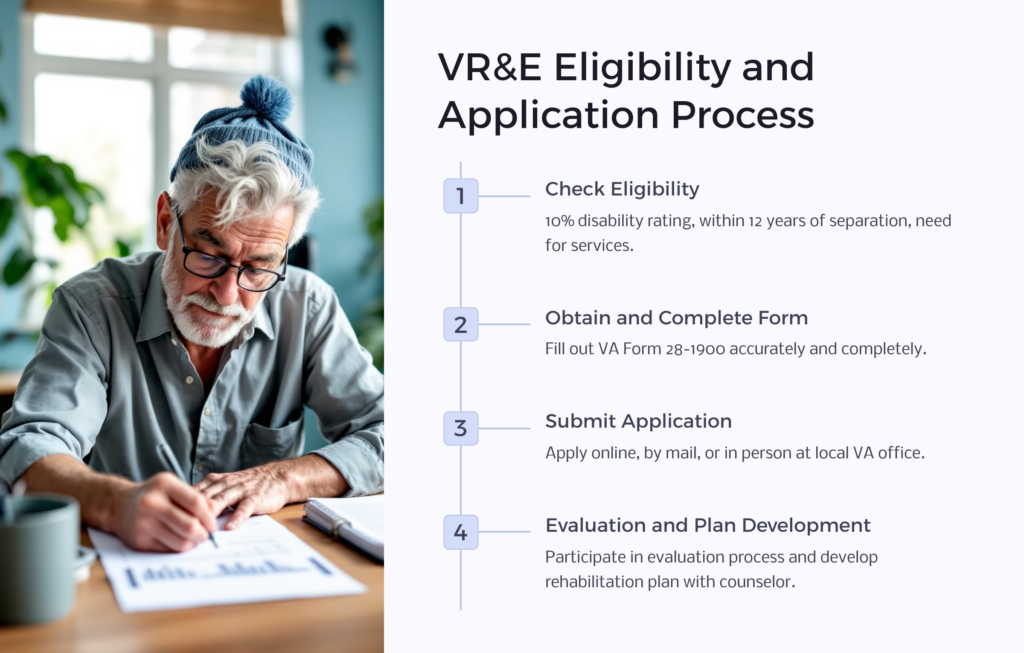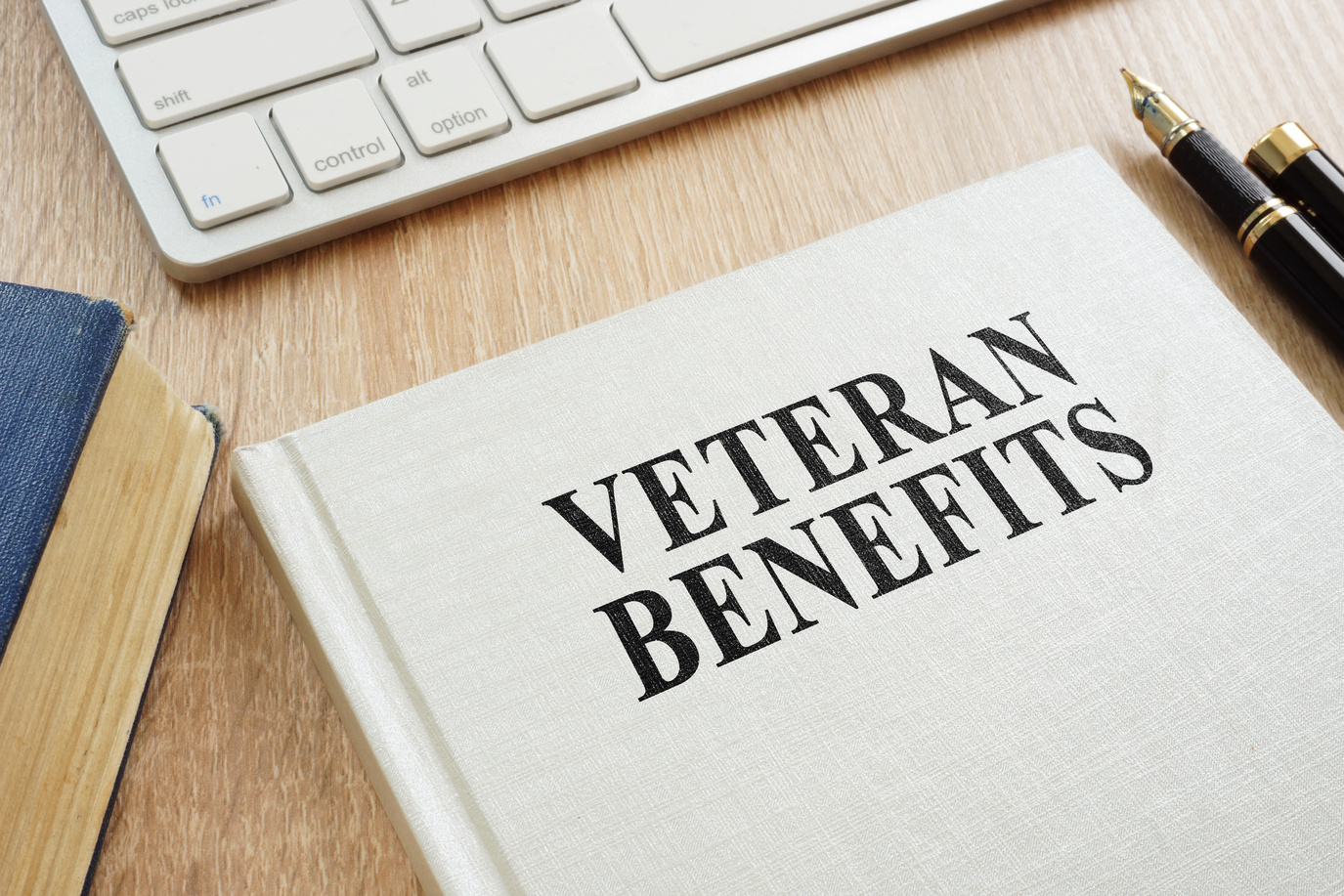If you’re a veteran with a service-connected disability and looking for assistance in pursuing education or employment goals, you may qualify for Chapter 31 VA benefits.
Also called the Vocational Rehabilitation and Employment (VR&E) program, Chapter 31 can provide veterans with various services and support to help them achieve their career aspirations.
This article walks you through the steps in applying for Chapter 31 VA benefits, including determining eligibility and filing an application.
Chapter 31 VA Rates in 2024
The Chapter 31 rates were updated October 1, 2023. The new rates each year are based on the CPI (Consumer Price Index), which is essentially a measure of inflation. These new rates are based on a 6.2% increase in CPI.
The rates also depend on the type of training you are receiving and also how many dependents you have.
Institutional; Nonpay or nominal pay work experience in a facility of a Federal, State, local, or federally recognized Indian tribe agency; Improvement of Rehabilitation Potential:
| TRAINING TIME | 0 DEPENDENTS | 1 DEPENDENT | 2 DEPENDENTS | EACH ADDITIONAL DEPENDENT |
| FULL TIME | $768.42 | $953.15 | $1,123.23 | $81.85 |
| HALF TIME | $386.32 | $478.66 | $562.64 | $42.00 |
Nonpay or nominal pay on-job training in a facility of a Federal, State, local, or federally recognized Indian tribe agency; Training in the home; Vocational course in a rehabilitation facility or sheltered workshop; Independent instructor:
| TRAINING TIME | 0 DEPENDENTS | 1 DEPENDENT | 2 DEPENDENTS | EACH ADDITIONAL DEPENDENT |
| FULL TIME | $768.42 | $953.15 | $1,123.23 | $81.85 |
Farm Cooperative, Apprenticeship or other On-Job Training:
| TRAINING TIME | 0 DEPENDENTS | 1 DEPENDENT | 2 DEPENDENTS | EACH ADDITIONAL DEPENDENT |
| FULL TIME | $671.84 | $812.47 | $926.35 | $60.89 |
For other combinations of work training or more part-time rates, check Veterans Affairs VR&E Fiscal Year 2024 Subsistence Rates. The maximum monthly rate a veteran can earn for Chapter 31 Subsistence Allowance is $3,251.38.
How Does Chapter 31 Work?

VA Chapter 31 benefits program is designed to help eligible veterans overcome barriers to employment and achieve maximum independence, employment, and economic self-sufficiency. The program is available to veterans with a service-connected disability rating of at least 10% or a memorandum rating of 20% or more from the VA.
The benefits provided under Chapter 31 can be tailored to meet the individual needs and goals of each eligible veteran, such as:
Vocational counseling involves helping veterans identify their career interests, strengths, and limitations and develop a vocational rehabilitation plan.
Education and training involve providing financial assistance for pursuing education or training necessary to achieve vocational rehabilitation plan goals. This may include college or vocational training, apprenticeships, or other educational programs.
Job search assistance involves job search techniques, resume writing, interview skills, and job placement.
They provide a range of supportive services to help veterans achieve their vocational rehabilitation goals. This may include transportation, vocational tools and equipment, and medical and dental services related to their rehabilitation.
Independent living services for veterans who need assistance with activities of daily living due to their service-connected disability can receive assistance with developing independent living skills.
What is Veteran Readiness and Employment (VR&E)?

Veteran Readiness and Employment (VR&E), formerly the Vocational Rehabilitation and Employment program, is a part of the U.S. Department of Veterans Affairs (VA) benefits program that provides vocational rehabilitation and employment services for veterans with service-connected disabilities.
The program is designed to help eligible veterans overcome barriers to employment and achieve maximum independence, employment, and economic self-sufficiency.
As mentioned, veterans with a service-connected disability rating of at least 10% or a memorandum rating of 20% or more from the VA may qualify for VR&E services. Additionally, veterans within 12 years of separation from active military service may be eligible for VR&E services.
The VR&E program provides a range of services to eligible veterans, including:
Comprehensive Evaluation
Veterans receive a thorough evaluation to determine their unique needs and goals for vocational rehabilitation.
Vocational Counseling
Veterans work with a vocational rehabilitation counselor to develop a rehabilitation plan that outlines their goals, needs, and services to be provided.
Education and Training
Veterans can receive financial assistance for pursuing the education or training necessary to achieve their vocational rehabilitation plan goals. This may include college or vocational training, apprenticeships, or other educational programs.
Job Search Assistance
Veterans can receive assistance with job search techniques, resume writing, interview skills, and job placement.
Supportive Services
Veterans can receive various support services to help them achieve their vocational rehabilitation goals. This may include transportation, vocational tools and equipment, and medical and dental services related to their rehabilitation.
Independent Living Services
Veterans who need assistance with activities of daily living due to their service-connected disability can receive assistance with developing independent living skills.
The VR&E program is designed to be flexible and individualized, with services tailored to meet each veteran’s unique needs and goals. The program is intended to provide eligible veterans with the tools and resources they need to successfully transition to civilian employment and thrive in their post-service lives.
How Do I Know Whether I Qualify for VR&E Benefits?

For VR&E eligibility, you must meet specific criteria, which include:
- Have a service-connected disability rating of at least 10 percent from the Department of Veterans Affairs (VA)
- Be within 12 years of separation from active military service or 12 years from the date they were first notified of a service-connected disability rating.
- Need vocational rehabilitation services to overcome an employment handicap resulting from their service-connected disability.
- Be able to benefit from vocational rehabilitation and employment services to become employable.
If you’re receiving VA disability compensation, you may also qualify for VR&E benefits if you have a severe employment handicap, even if your disability rating is less than 10 percent.
Applying for VR&E Benefits
Applying for VR&E benefits can be complex, but the VA provides resources and support through every step of the process.
Obtain the Necessary Forms
The VA Form 28-1900 is the application form you need for VR&E benefits. You can download this form from the VA website or get it from your local VA office.
Complete the Application
Fill out the VA Form 28-1900 completely and accurately. Provide all the required information, including your details, military service history, and disability information.
You can also include any additional information or documentation that might be helpful for your application.
Provide Documentation
You’ll need to provide documentation of your disability, such as medical records or a VA disability rating decision. These documents are necessary to prove that you have a service-connected disability limiting your ability to work. Submit these documents along with your application.
Submit Your Application
You can submit your application by mail, in person at your local VA office, or online through the VA website. If you submit your application online, you will receive a confirmation that your application has been received.
Participate in the Evaluation Process
After receiving your application, you will be contacted to participate in an evaluation process to determine your eligibility for VR&E benefits. This process may include a meeting with a VR&E counselor and medical or vocational evaluations.
Develop a Rehabilitation Plan
If you are eligible for VR&E benefits, you will work with a VR&E counselor to develop a rehabilitation plan. This plan will outline your goals, objectives, and services needed to achieve your vocational rehabilitation. Your rehabilitation plan will be personalized to your needs and may include education or training, employment, and other support services.
Implement Your Rehabilitation Plan
With the help of your VR&E counselor, you will implement your rehabilitation plan. This may include attending school or training programs, receiving employment assistance, or accessing other support services. You will work closely with your counselor to achieve your vocational goals and complete your rehabilitation plan.
Does the Chapter 31 VA Benefits Pay Scale Change Every Year?
The Chapter 31 benefits pay scale can change every year. The pay scale for Chapter 31 benefits is based on the Vocational Rehabilitation and Employment (VR&E) program, designed to help veterans with service-connected disabilities prepare for, find, and keep suitable employment.
The pay scale for Chapter 31 benefits is based on the national average wage index and is adjusted annually based on changes in the index. The pay scale for Chapter 31 benefits is determined using the national average wage index, which is calculated by the Social Security Administration (SSA) based on the wages of workers covered by Social Security. The index is adjusted annually based on changes in the average wage level in the United States.
The VA then uses the national average wage index to calculate the maximum monthly benefit amount for each individual enrolled in the VR&E program. The maximum monthly benefit amount varies depending on several factors, such as the veteran’s disability rating, the length of time the veteran served on active duty, and the cost of living in the veteran’s geographic location.
The maximum monthly benefit amount is different from what every veteran will receive. In addition, the veteran’s benefits may be lower depending on various factors, including the cost of the education or training program the veteran is enrolled in, the veteran’s income, and the veteran’s eligibility for other benefits.
Therefore, the pay scale can change from year to year. Therefore, you need to stay current with the current pay scale to ensure you’re receiving the appropriate benefits. You can find the current pay scale on the VA’s website or by contacting their local VA office.
Will Chapter 31 Pay for Vocational Rehabilitation?
Suppose you are eligible for Chapter 31 benefits, and your VA counselor determines that you need vocational rehabilitation to overcome your disability. In that case, the VA will generally assist in training, education, job counseling, and other services to help you become employable.
However, it’s important to note that eligibility for Chapter 31 benefits is determined on a case-by-case basis. The VA counselor will assess your needs and capabilities before approving any services. Therefore, the best way to determine if you qualify for Chapter 31 VR&E benefits is to contact your local VA office and speak with a counselor. They can guide you through the application process and help determine your eligible benefits.
What Exactly Does Vocational Rehab Entail?
Vocational rehabilitation (VR) is a process that helps individuals with disabilities overcome barriers to employment and achieve their career goals. Vocational rehabilitation services can include various interventions tailored to the individual’s needs, abilities, and employment goals. In the context of Chapter 31 of the VA, VR services may include:
Vocational Evaluation: A comprehensive assessment that includes testing, interviews, and other measures to identify the individual’s strengths, interests, and vocational potential. The evaluation helps the VR counselor develop a plan for services specific to the individual’s needs.
Career Counseling: Once the individual’s vocational potential is assessed, the VR counselor provides guidance and counseling to help them make informed decisions about their career goals. This can include identifying job opportunities, exploring educational and training programs, and providing information on the job market.
Rehabilitation Planning: Based on the vocational evaluation and career counseling, the VR counselor develops an Individualized Rehabilitation Plan (IRP) that outlines specific services and interventions to help individuals achieve their employment goals. The plan is designed to be flexible and can be adjusted as the individual’s needs change.
Training: The VR program may provide training in specific job skills or offer general education classes to help individuals achieve their career goals. The training may take place in a classroom, on the job, or through online learning.
Job Placement: Once the individual has completed their training, the VR program assists with job search and placement. This may include resume writing, interview coaching, and referrals to job openings.
On-The-Job Support: After the individual has secured employment, the VR counselor may provide support to ensure a smooth transition into the workplace. This may include accommodations, job coaching, and other support services.
How Much is the Chapter 31 Allowance Rate?
The amount of the monthly stipend provided through Chapter 31 VR&E varies based on the veteran’s circumstances, such as their dependents, income, and vocational goals. The stipend is intended to help cover the veteran’s basic living expenses while participating in the program.
According to the 2023 VA disability pay Chart, the monthly subsistence allowance for veterans participating in Chapter 31 VR&E is based on the attendance rate for the full-time post-secondary educational institution in their residence. For example, if a veteran attends a full-time college program in a state with a maximum rate of $1,000 per month, their monthly subsistence allowance would be $1,000.
However, the actual amount of the monthly stipend may be adjusted based on the veteran’s circumstances and the cost of living in their area. In addition to the monthly stipend, veterans participating in the Chapter 31 VR&E program may also be eligible for other benefits, such as payment for tuition, books, and supplies, as well as reimbursement for other expenses related to their vocational rehabilitation plan.
What is the Difference Between Chapter 31 and Chapter 33?
Chapter 31 and Chapter 33 are programs offered by the Department of Veterans Affairs (VA) to help eligible veterans access education and training benefits. However, there are some critical differences between the two programs:
Eligibility: The eligibility criteria for Chapter 31 and Chapter 33 are different. Chapter 31 is open to veterans with a service-connected disability rating of 10% or higher who need vocational rehabilitation services to prepare for, find, and maintain employment. Chapter 33, on the other hand, is open to veterans who served on active duty after September 10, 2001, with at least 90 days of aggregate service or were discharged with a service-connected disability after 30 days.
Purpose: The purpose of Chapter 31 is to provide vocational rehabilitation services to help veterans with service-connected disabilities overcome barriers to employment and achieve their career goals. Chapter 33, also known as the Post-9/11 GI Bill, provides education and training benefits to help eligible veterans further their education or training and enhance their career opportunities.
Benefits: The benefits provided by Chapter 31 and Chapter 33 are also different. Chapter 31 provides various benefits, including vocational evaluation, counseling, training, job placement assistance, and financial assistance in the form of a monthly subsistence allowan
e. Chapter 33 provides education and training benefits, including tuition and fees, a monthly housing allowance, and a stipend for books and supplies.
Length of Benefits: The length of benefits under Chapter 31 and Chapter 33 also varies. The length of time a veteran can receive benefits under Chapter 31 is determined by their individualized rehabilitation plan, which is developed with the assistance of a VR&E counselor. The length of benefits under Chapter 33 is determined by the time the veteran served on active duty after September 10, 2001, with a minimum of 36 months of service required to be eligible for the full benefit.
Will VR&E Provide Financial Assistance Towards Education?
Yes, the VR&E (Vocational Rehabilitation and Employment) program administered by the U.S. Department of Veterans Affairs can provide financial assistance for education as part of its services. The program is designed to help eligible veterans with service-connected disabilities overcome barriers to employment, which may include education and training.
If a veteran is eligible for VR&E services, they can work with a Vocational Rehabilitation Counselor (VRC) to create an Individualized Rehabilitation Plan (IRP), which outlines the specific services and supports needed to achieve their employment goals. The IRP may include educational and training programs, and the VR&E program can pay for tuition, fees, books, and other necessary supplies.
It is important to note that eligibility for VR&E services and the amount of financial assistance provided is determined on a case-by-case basis and depends on the individual’s needs and goals. Veterans interested in applying for VR&E services should contact their local VA office or visit the VA’s website for more information.
When Should I Apply for VR&E Benefits?

If you are a service member or veteran with a service-connected disability interested in pursuing vocational rehabilitation and employment (VR&E) benefits, you should consider applying as soon as possible.
Applying for VR&E benefits can take some time, so starting the process early is important. You can begin by contacting your nearest VA Regional Office or VA Medical Center and speaking with a VR&E counselor.
The VR&E counselor will work with you to determine your eligibility for the program and help you develop a personalized plan to achieve your employment goals. The counselor will also inform you about the various services and benefits available through the VR&E program.
We can help you identify training and employment opportunities that align with your vocational rehabilitation plan and career goals. Contact us to receive the assistance you deserve.
 Benefits.com Advisors
Benefits.com Advisors
With expertise spanning local, state, and federal benefit programs, our team is dedicated to guiding individuals towards the perfect program tailored to their unique circumstances.
Rise to the top with Peak Benefits!
Join our Peak Benefits Newsletter for the latest news, resources, and offers on all things government benefits.





















